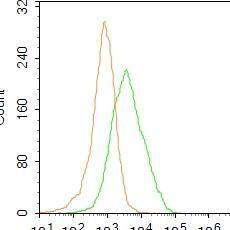英文名称:CD66a
中文名称:癌胚抗原相关细胞粘附分子1抗体
别 名:CEACAM1; carcinoembryonic antigen-related cell adhesion molecule 1 isoform 1 precursor; Antigen CD66; BGP; BGP 1; BGP I; BGP1;BGPI; Biliary glycoprotein 1; Biliary glycoprotein adhesion molecule; Biliary glycoprotein; Carcinoembryonic antigen related cell adhesion molecule 1; CD66 antigen; CD66a antigen; CEACAM 1; bb-1; C-CAM; Cc1; Cea-1; Cea-7; Cea1; Cea7; Hv-2; Hv2; mCEA1; Mhv-1; MHVR; MHVR1; mmCGM1; mmCGM1a; mmCGM2; CEAM1_HUMAN.
研究领域肿瘤: 细胞粘附分子 细胞表面分子
抗体来源:Rabbit
克隆类型:Polyclonal
交叉反应: Human, (predicted: Mouse, Rat, Dog, Horse, )
产品应用:WB=1:500-2000 ELISA=1:5000-10000 IHC-F=1:100-500 Flow-Cyt=1ug/Test ICC=1:100-500 IF=1:100-500 (石蜡切片需做抗原修复)
not yet tested in other applications.
optimal dilutions/concentrations should be determined by the end user.
理论分子量:57kDa
细胞定位:细胞膜 分泌型蛋白
性 状:Liquid
浓 度:1mg/ml
免 疫 原:KLH conjugated synthetic peptide derived from human CEACAM1: 241-310/526 <Extracellular>
亚 型:IgG
纯化方法:affinity purified by Protein A
缓 冲 液:0.01M TBS(pH7.4) with 1% BSA, 0.03% Proclin300 and 50% Glycerol.
保存条件:Shipped at 4℃. Store at -20 °C for one year. Avoid repeated freeze/thaw cycles.
注意事项:This product as supplied is intended for research use only, not for use in human, therapeutic or diagnostic applications.
PubMedPubMed
产品介绍: This gene encodes a member of the carcinoembryonic antigen (CEA) gene family, which belongs to the immunoglobulin superfamily. Two subgroups of the CEA family, the CEA cell adhesion molecules and the pregnancy-specific glycoproteins, are located within a 1.2 Mb cluster on the long arm of chromosome 19. Eleven pseudogenes of the CEA cell adhesion molecule subgroup are also found in the cluster. The encoded protein was originally described in bile ducts of liver as biliary glycoprotein. Subsequently, it was found to be a cell-cell adhesion molecule detected on leukocytes, epithelia, and endothelia. The encoded protein mediates cell adhesion via homophilic as well as heterophilic binding to other proteins of the subgroup. Multiple cellular activities have been attributed to the encoded protein, including roles in the differentiation and arrangement of tissue three-dimensional structure, angiogenesis, apoptosis, tumor suppression, metastasis, and the modulation of innate and adaptive immune responses. Multiple transcript variants encoding different isoforms have been reported, but the full-length nature of all variants has not been defined. [provided by RefSeq, May 2010].
Subcellular Location:
Isoform 1: Cell membrane; Single-pass type I membrane protein. Isoform 2: Secreted.Isoform 3: Secreted. Isoform 4: Secreted. Isoform 5: Cell membrane; Single-pass type I membrane protein. Isoform 6: Cell membrane; Single-pass type I membrane protein. Isoform 7: Cell membrane; Single-pass type I membrane protein. Isoform 8: Cell membrane; Single-pass type I membrane protein. Note=Localizes to sites of cell-cell contact.
Similarity:
Belongs to the immunoglobulin superfamily. CEA family.
Contains 3 Ig-like C2-type (immunoglobulin-like) domains.
Contains 1 Ig-like V-type (immunoglobulin-like) domain.
SWISS:
P13688
Gene ID:
634
Database links:
Entrez Gene: 634 Human
Omim: 109770 Human
SwissProt: P13688 Human
Unigene: 512682 Human

